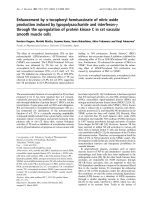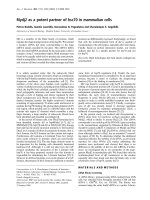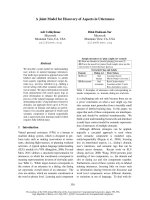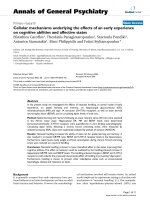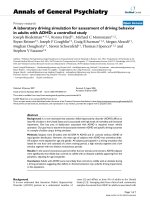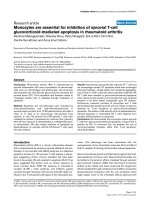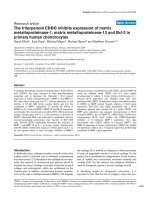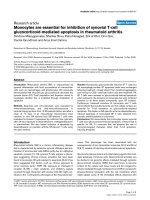Báo cáo y học: " No genetic evidence for involvement of Deltaretroviruses in adult patients with precursor and mature T-cell neoplasms" doc
Bạn đang xem bản rút gọn của tài liệu. Xem và tải ngay bản đầy đủ của tài liệu tại đây (1.02 MB, 7 trang )
BioMed Central
Page 1 of 7
(page number not for citation purposes)
Retrovirology
Open Access
Research
No genetic evidence for involvement of Deltaretroviruses in adult
patients with precursor and mature T-cell neoplasms
Thomas Burmeister*
1
, Stefan Schwartz
1
, Michael Hummel
2
, Dieter Hoelzer
3
and Eckhard Thiel
1
Address:
1
Charité Universitätsmedizin Berlin, Campus Benjamin Franklin, Medizinische Klinik III, Hindenburgdamm 30, 12200 Berlin, Germany,
2
Charité Universitätsmedizin Berlin, Campus Benjamin Franklin, Institut für Pathologie, Hindenburgdamm 30, 12200 Berlin, Germany and
3
Johann Wolfgang Goethe-Universität, Medizinische Klinik III, Theodor Stern-Kai 7, 60590 Frankfurt/Main, Germany
Email: Thomas Burmeister* - ; Stefan Schwartz - ;
Michael Hummel - ; Dieter Hoelzer - ; Eckhard Thiel -
* Corresponding author
Abstract
Background: The Deltaretrovirus genus comprises viruses that infect humans (HTLV), various
simian species (STLV) and cattle (BLV). HTLV-I is the main causative agent in adult T-cell leukemia
in endemic areas and some of the simian T-cell lymphotropic viruses have been implicated in the
induction of malignant lymphomas in their hosts. BLV causes enzootic bovine leukosis in infected
cattle or sheep. During the past few years several new Deltaretrovirus isolates have been described
in various primate species. Two new HTLV-like viruses in humans have recently been identified and
provisionally termed HTLV-III and HTLV-IV. In order to identify a broad spectrum of
Deltaretroviruses by a single PCR approach we have established a novel consensus PCR based on
nucleotide sequence data obtained from 42 complete virus isolates (HTLV-I/-II, STLV-I/-II/-III, BLV).
The primer sequences were based on highly interspecies-conserved virus genome regions. We
used this PCR to detect Deltaretroviruses in samples from adult patients with a variety of rare T-
cell neoplasms in Germany.
Results: The sensitivity of the consensus PCR was at least between 10
-2
and 10
-3
with 100%
specificity as demonstrated by serial dilutions of cell lines infected with either HTLV-I, HTLV-II or
BLV. Fifty acute T-cell lymphoblastic leukemia (T-ALL) samples and 33 samples from patients with
various rare mature T-cell neoplasms (T-PLL, Sézary syndrome and other T-NHL) were
subsequently investigated. There were no cases with HTLV-I, HTLV-II or any other
Deltaretroviruses.
Conclusion: The results rule out a significant involvement of HTLV-I or HTLV-II in these disease
entities and show that other related Deltaretroviruses are not likely to be involved. The newly
established Deltaretrovirus PCR may be a useful tool for identifying new Deltaretroviruses.
Background
Retroviruses are the main etiologic agents in a variety of
malignant diseases in animals [1]. Bovine leukemia virus
(BLV) was the first Deltaretrovirus to be discovered in
1969 by electron microscopy [2], but it was not until 1985
that the first complete nucleotide sequence of an isolate
Published: 7 February 2007
Retrovirology 2007, 4:11 doi:10.1186/1742-4690-4-11
Received: 20 September 2006
Accepted: 7 February 2007
This article is available from: />© 2007 Burmeister et al; licensee BioMed Central Ltd.
This is an Open Access article distributed under the terms of the Creative Commons Attribution License ( />),
which permits unrestricted use, distribution, and reproduction in any medium, provided the original work is properly cited.
Retrovirology 2007, 4:11 />Page 2 of 7
(page number not for citation purposes)
was reported [3]. Since the discovery of HTLV-I [4] and
HTLV-II [5] and their closely related simian counterparts
STLV-I [6] and STLV-II [7] several Deltaretrovirus isolates
have been described in various non-human primate spe-
cies. In 1994, a third simian Deltaretrovirus, later desig-
nated as STLV-III, was identified in a Hamadryas Baboon
(Papio Hamadryas) [8-10]. Until recently no human coun-
terparts of STLV-III were known, but in 2005 two inde-
pendent research groups described human isolates that
showed high homology to STLV-III and were considered
to be HTLV-III isolates [11,12]. Moreover, a fourth Del-
taretrovirus was identified in a single human individual
from the Rain Forest in Cameroon. It did not show suffi-
cient homology to be classified as primate T-cell lympho-
tropic virus (PTLV) type I, II or III and was thus considered
to be a species representative of a hitherto unknown puta-
tive PTLV-IV virus group [12].
HTLV-I and STLV-I are etiologically linked to the induc-
tion of certain T-cell lymphomas/leukemias in their hosts
[13,14]. The oncogenic action of the virus is mediated by
the viral tax and rex genes that act as transcription factors,
thereby promoting cell growth and malignant transforma-
tion However, the etiology of many human malignant T-
cell and T-/NK-cell disorders is still not well understood.
On the other hand a great deal of knowledge has been
gained in the last years on the molecular biology of Del-
taretroviruses, since a large number of new isolates have
been described. To investigate the possible involvement
of Deltaretroviruses in various human T-cell neoplasms,
we have constructed a novel Deltaretrovirus consensus
PCR based on nucleotide sequence alignments of all 42
complete Deltaretrovirus isolates published to date.
Highly conserved virus genome regions were identified
that allowed the construction of a generic PCR, capable of
detecting all known Deltaretroviruses.
Results
A total of 42 complete Deltaretrovirus isolates could be
retrieved from the EMBL/Genbank/DDBJ nucleotide
sequence database (Table 1). These included 13 HTLV-I,
12 HTLV-II, 4 STLV-I, 3 STLV-II, 5 STLV-III, and 5 BLV iso-
Table 2: Patient and disease characteristics.
Disease entity (N) N Median age (range) [years]
Precursor T-cell (50) Early T-cell lymphoblastic 11
Cortical (thymic) T-cell
lymphoblastic
31 34 (17–63)
Mature T-cell lymphoblastic 8
Mature T-cell (31) T-prolymphocytic 16
Sézary syndrome and Mycosis
fungoides
5
Ki-1 large T-cell lymphoma 3 65 (48–83)
Intestinal T-cell lymphoma 1
Other (unspecified) peripheral T-
NHL
6
NK cell disorders (2) LGL leukemia 2 29 and 78
Table 1: Accession number of the 42 virus isolates used in the nucleotide sequence alignments.
Virus EMBL/Genbank/DDBJ accession number
HTLV-I [EMBL:AY563954] (Brazilian isolate), [EMBL:AY563953] (Brazilian isolate), [GenBank:NC_001436], [EMBL:AF259264] (isolate WHP
from China), [EMBL:AF139170
] (from an HTLV-I/II seroindeterminate patient), [EMBL:J02029] (Japanese ATL isolate),
[EMBL:AF033817
], [EMBL:L03561], [EMBL:D13784] (Caribbean isolate), [EMBL:L02534] (Melanesian isolate), [EMBL:U19949] (isolate
from an ATL patient), [EMBL:AF042071
] (isolate from Germany), [EMBL:L36905] (from a patient with post-transfusion spastic
paraparesis)
HTLV-II [GenBank:NC_001488
], [EMBL:AF326584] (Brazilian isolate), [EMBL:AF326583] (Brazilian isolate, strain RP329), [EMBL:AF412314]
(with HIV coinfection), [EMBL:AF139382
] (Brazilian isolate), [EMBL:AF074965] (isolate from a Guahibo Indian from Venezuela),
[EMBL:M10060
], [EMBL:L11456] (Guyami Indian isolate), [EMBL:Y14365] (Congolese Bambute Efe Pygmy isolate), [EMBL:X89270]
(Italian isolate), [EMBL:L20734
], [EMBL:Y13051] (African isolate, subtype b)
STLV-I [GenBank:NC_000858
] (from a naturally infected tantalus monkey from Central Africa), [EMBL:AY590142] (in Macaca arctoides),
[EMBL:Z46900
] (from Celebes macaques), [EMBL:AF074966] (isolate Tan90 from Central African Republic)
STLV-II [GenBank:NC_001815
], [EMBL:Y14570] (STLV-PP from Pan paniscus), [EMBL:U90557] (from Pan paniscus)
STLV-III [EMBL:AF517775
] (from Papio hamadryas papio from Senegal), [GenBank:NC_003323] (from red-capped mangabeys (Cercocebus
torquatus) from Cameroon), [EMBL:AY217650
] (from Theropithecus gelada), [EMBL:AY222339] (from a red-capped mangabey –
Cercocebus torquatus torquatus – from Nigeria), [EMBL:Y07616
] (STLV-PH969 from a Hamadryas baboon)
BLV [GenBank:NC_001414
], [EMBL:AF257515] (from a Holstein cow from Argentina), [EMBL:K02120] (Japanese isolate),
[EMBL:AF033818
], [EMBL:D00647] (Australian isolate)
Retrovirology 2007, 4:11 />Page 3 of 7
(page number not for citation purposes)
lates. A common feature of the Deltaretrovirus genus is
the use of proline tRNA as a primer for the complemen-
tary minus-strand DNA synthesis. tRNA genes are highly
conserved between different species [15]. Alignment of
the collected sequences showed a very high degree of con-
servation of this functionally important region. Addition-
ally, a second highly conserved region was identified
approximately 1.8 kb 3' of the tRNA binding site (Fig. 1).
The pol ORF of HTLV-I/-II/BLV is expressed by using two
ribosomal -1 frame shifts, and the second frame shift with
the transcription start site of the pol ORF lies within this
region [1]. The high degree of conservation of this region
is thus understandable. A phylogenetic tree constructed
from the aligned region illustrates the genetic relation-
ships (Fig. 2). No other genomic regions with a similarly
high degree of conservation were identified (see Addi-
tional File 1). Degenerate primers complementary to
these regions were constructed (Fig. 1). The degeneracy of
the primers was moderate (4-fold for (+) and 12-fold for
(-)). The PCR was tested using serial dilutions of Deltaret-
rovirus-infected cell line DNA in human leukocyte DNA
under various conditions (Fig. 3). Retrovirus-infected cell
lines frequently harbor more than one copy of the virus,
although often some of these copies are defective. When
calculating PCR sensitivity this factor has to be taken into
account. The HTLV-I/HTLV-II/BLV copy number has been
determined in various cell lines which revealed copy num-
bers between 1 and 17 per cell [16-18]. We thus assumed
a sensitivity of 10
-2
– 10
-3
for our PCR. This sensitivity
appeared highly sufficient for our purpose. The PCR pro-
duced a faint 657 bp sideband when testing human DNA
or cell line DNA diluted in human DNA (Fig. 3). Cloning
and sequencing of the 657 bp product (EMBL nucleotide
sequence database Acc No [EMBL:AM422011
]) and a suc-
cessive BLAST search revealed that it originated from
amplification of a sequence on chromosome 3 (Acc No
[EMBL:AC114481
], Ncl 81342-80686) and 11 (Acc No
[EMBL:AP000785
], Ncl 74948–75403) by primer delta-F.
It should be noted that the PCR sensitivity could be fur-
ther increased to 10-3 – 10-4 (while retaining specificity)
by lowering the annealing temperature to 60°C and
increasing the number of PCR cycles but at the expense of
a stronger 657 bp sideband.
A total of 83 samples were obtained from patients with
various rare mature T-cell (N = 31) and precursor T-cell
neoplasms (N = 50) and from 2 patients with NK-cell dis-
orders. All samples had been thoroughly characterized
immunologically and genetically and contained a high
percentage (>= 50%) of malignant cells (Table 2). All sam-
ples were fresh (i.e. unfixated) tumor material, and the
DNA quality was ensured by various control PCRs.
None of the investigated samples yielded a PCR product
indicative of the presence of a Deltaretrovirus. The parallel
investigation of positive controls led to the expected
results.
Discussion
While the etiological involvement of HTLV-I in endemic
adult T-cell leukemia/lymphoma is beyond dispute there
have been repeated controversies whether this virus might
also play a role in other T-cell neoplasms such as T-prol-
ymphocytic leukemia [19], Sézary syndrome or Mycosis
fungoides [20-22]. The situation is further complicated by
the fact that the classification of T-NHLs has been evolving
and changing over the years as new disease entities are rec-
ognized and refined diagnostic criteria are established
[23,24]. Thus the results of older studies may not always
be fully transferable to today's situation. Some investiga-
tors have also suggested that a truncated HTLV-I may play
a role in certain T-NHLs [19,25]. On the other hand
HTLV-II has not been convincingly linked to any specific
malignant T-cell disorder. The simian Deltaretroviruses
are implicated in lymphomatous diseases in various sim-
ian hosts (reviewed in [1]). The newly discovered HTLV-
PCR primer regions with consensus primersFigure 1
PCR primer regions with consensus primers. The accession
numbers of the different isolates are given on the left. The
first region corresponds to the proline tRNA binding site;
the start of the pol ORF is underlined in the second region
(site of ribosomal frameshift).
Retrovirology 2007, 4:11 />Page 4 of 7
(page number not for citation purposes)
III and HTLV-IV isolates have not yet been fully character-
ized, and their distribution or possible involvement in
human disease is unknown.
A few previous investigations performed on precursor T-
cell neoplasms in Germany were mainly based on HTLV-I
serology [26] which may not be as reliable as nucleic acid-
based techniques [27]. Germany has a low HTLV-I sero-
prevalence, but virus isolates without linkage to endemic
areas have occasionally been reported [28].
The causes of most malignant T-cell disorders are only
partially understood. Numerous recurrent genetic aberra-
tions have been described [29] but a clear and detailed
model of disease development still does not exist. Onco-
genic viruses such as Epstein-Barr virus or HTLV-I are well
established causative factors in various human T-cell lym-
phomas and leukemias [29]. It appears possible that yet
undetected Deltaretroviruses may play a role in human T-
cell malignancies.
We developed a consensus PCR for detecting Deltaretrovi-
ruses based on highly conserved genomic sequences of all
published complete Deltaretrovirus isolates. Since this
PCR is based on highly interspecies conserved sequence
motifs it may also be capable of detecting related but hith-
erto unknown Deltaretroviruses. However, despite high
sensitivity and specificity of our PCR approach, no Del-
taretrovirus-positive cases were found in our series of sam-
ples.
Conclusion
The results rule out a role of known Deltaretroviruses in
the disease entities under investigation here. The involve-
ment of a hitherto undetected Deltaretrovirus is not com-
pletely excluded but rendered more unlikely. Truncated
proviruses that have lost their 5'-region with the tRNA
binding site may also escape detection by our PCR system.
Despite these negative results, our newly established con-
sensus PCR may be a useful tool in the search for and
characterization of new Deltaretroviruses in primates and
other mammals.
Methods
Cell lines
The following cell lines were used: BL3.1 (infected with
BLV, a bovine lymphoma cell line, [30]), MJ [G11]
(infected with HTLV-I, derived from a human cutaneous
T-cell lymphoma, [31]) and Mo T (infected with HTLV-II,
derived from a patient with hairy cell leukemia, [32]). All
cell lines were obtained from the ATCC (Acc No CRL-
2306, TIB-8294, and TIB-8066, respectively). Cell culture
was done according to the recommendations of the sup-
plier. DNA isolated from the cell lines was used to prepare
serial dilution rows.
DNA isolation
DNA was isolated from sample material or cell lines using
the PureGene kit (Biozym Diagnostik, Hessisch Olden-
dorf/Germany) and dissolved in Tris/EDTA buffer at a
concentration of 60 ng/μl.
Preparation of cell line dilution series
Serial dilutions of cell line DNA in DNA from buffy coats
of blood donors were prepared as recently described [33].
Patient samples
All samples were obtained for diagnostic purposes, and
we retrospectively investigated archived material. The
patients had given their consent for scientific investiga-
tions. The T-precursor samples were obtained within the
German Multicenter Study Group for Adult Acute Lym-
phoblastic Leukemia (GMALL). Our study complied with
the Helsinki Declaration.
PCR method
The HotStarTaq kit (QIAGEN, Hilden/Germany) was used
with 200 ng sample DNA, 400 nM of each PCR primer
delta-F 5'-CARKTGGGGGCTCGTCCGGGAT-3' and delta-
R 5'-GGCCTGGAGGCGYTCHRGTTTAA-3', buffer condi-
tions and polymerase mix as recommended by the sup-
plier. The primers were optimized derivatives of those
previously published [34] and HPLC-purified. The follow-
Phylogenetic tree based on the nucleotide sequence align-ment of the amplified regionFigure 2
Phylogenetic tree based on the nucleotide sequence align-
ment of the amplified region. The recently described HTLV-
III and HTLV-IV isolates are not included since no complete
isolates have been published yet. The tree is not intended to
set up a phylogeny but to illustrate the genetic relationships
between the isolates.
Retrovirology 2007, 4:11 />Page 5 of 7
(page number not for citation purposes)
Deltaretrovirus PCR tested in serial dilutions of cell linesFigure 3
Deltaretrovirus PCR tested in serial dilutions of cell lines. Cell line DNA was diluted in genomic DNA from healthy individuals.
A: cell line Mo T (HTLV-II-infected), B: cell line MJ (HTLV-I-infected), C: cell line BL3.1 (BLV-infected). First and last lane in
every gel: φX174/Hae III size standard (QIAGEN, Hilden/Germany). No cell line harboring STLV-III, HTLV-III or HTLV-IV is
currently available. All cell lines yield a PCR product of approximately 1.8 kB. A small sideband at 657 bp is visible which could
serve as an internal control for DNA integrity.
Retrovirology 2007, 4:11 />Page 6 of 7
(page number not for citation purposes)
ing cycler program was used on a GeneAmp 2400 Cycler
(PerkinElmer): 94°C for 15 minutes, 40 cycles (94°C for
20 seconds, 62°C for 20 seconds, 72°C for 90 seconds),
4°C.
Nucleotide sequence alignments
All available complete nucleotide sequences from Del-
taretrovirus isolates were collected from the EMBL/Gen-
bank/DDBJ database (Table 1), converted into FASTA file
format, and aligned using the ClustalX software [35].
Phylogenetic analysis
The PHYLIP program package [36], version 3.65 for
MacOS X, with the program modules dnacomp and draw-
gram was used with the default parameters to construct a
phylogenetic tree from the aligned sequences.
Immunophenotyping
Immunophenotyping by FACS analysis was done essen-
tially by standard methods described elsewhere [37].
Abbreviations
HTLV human T-cell lymphotropic virus
STLV simian T-cell lymphotropic virus
BLV bovine leukemia virus
PTLV primate T-cell lymphotropic virus
PCR polymerase chain reaction
PLL prolymphocytic leukemia
NHL Non Hodgkin lymphoma
ALL acute lymphoblastic leukemia
Competing interests
The author(s) declare that they have no competing inter-
ests.
Authors' contributions
TB designed and performed the laboratory work, particu-
larly the PCR, did the alignments and phylogenetic analy-
sis and wrote the paper. SS and ET performed
immunophenotyping of samples. MH characterized spe-
cific samples by analysis of T-cell receptor clonality. DH is
chairman of the German Multicenter Study Group for
Adult Acute Lymphoblastic Leukemia (GMALL) which
provided the T-ALL samples. All authors have read and
approved the manuscript.
Additional material
Acknowledgements
The authors are grateful to Mara Molkentin, Barbara Komischke and Rita
Lippoldt for their skillful technical assistance. They are indebted to Prof.
Harald Stein (Head of the Dept. of Pathology, Charité Campus Benjamin
Franklin) for giving them access to lymphoma DNA samples. TB and SS
were supported by the Deutsche Krebshilfe (German Cancer Aid, grant 10-
1988-Bu1). TB is also supported by the Berliner Krebsgesellschaft (Berlin
Cancer Society). Dr. J. Weirowski critically read the manuscript.
References
1. Coffin JM, Hughes SH, Varmus HE, (Eds): Retroviruses New York: Cold
Spring Harbor Laboratory Press; 1997.
2. Miller JM, Miller LD, Olson C, Gillette KG: Virus-like particles in
phytohemagglutinin-stimulated lymphocyte cultures with
reference to bovine lymphosarcoma. J Natl Cancer Inst 1969,
43:1297-1305.
3. Sagata N, Yasunaga T, Tsuzuku-Kawamura J, Ohishi K, Ogawa Y,
Ikawa Y: Complete nucleotide sequence of the genome of
bovine leukemia virus: its evolutionary relationship to other
retroviruses. Proc Natl Acad Sci USA 1985, 82:677-681.
4. Poiesz BJ, Ruscetti FW, Reitz MS, Kalyanaraman VS, Gallo RC: Isola-
tion of a new type C retrovirus (HTLV) in primary uncul-
tured cells of a patient with Sézary T-cell leukaemia. Nature
1981, 294:268-271.
5. Kalyanaraman VS, Sarngadharan MG, Robert-Guroff M, Miyoshi I,
Golde D, Gallo RC: A new subtype of human T-cell leukemia
virus (HTLV-II) associated with a T-cell variant of hairy cell
leukemia. Science 1982, 218:571-573.
6. Miyoshi I, Yoshimoto S, Fujishita M, Taguchi H, Kubonishi I, Niiya K,
Minezawa M: Natural adult T-cell leukemia virus infection in
Japanese monkeys. Lancet 1982, 2:658.
7. Chen YAM, Jang YJ, Kanki PJ, Yu QC, Wang JJ, Montali RJ, Samuel KP,
Papas TS: Isolation and characterization of simian T-cell
leukemia virus type II from new world monkeys. J Virol 1994,
68:1149-1157.
8. Goubau P, Van Brussel M, Vandamme A-M, Liu HF, Desmyter J: A
primate T-lymphotropic virus, PTLV-L, different from
human T-lymphotropic viruses types I and II, in a wild-
caught baboon. Proc Natl Acad Sci USA 1994, 91:2848-2852.
9. Van Brussel M, Goubau P, Rousseau R, Desmyter J, Vandamme AM:
The genomic structure of a new simian T-lymphotropic
virus, STLV-ph969, differs from that of human T-lympho-
tropic virus types I and II. J Gen Virol 1996, 77:347-358.
10. Van Brussel M, Salemi M, Liu MH-F, Gabriels J, Goubau P, Desmyter
J, Vandamme AM: The simian T-lymphotropic virus STLV-
PP1664 from Pan paniscus is distinctly related to HTLV-II
but differs in genomic organization.
Virology 1999, 243:366-379.
11. Calattini S, Chevalier SA, Duprez R, Bassot S, Froment A, Mahieux R,
Gessain A: Discovery of a new human T-cell lymphotropic
virus (HTLV-III) in Central Africa. Retrovirology 2005, 2:30.
12. Wolfe ND, Heneine W, Carr JK, Garcia AD, Shanmugam V, Tamoufe
U, Torimiro JN, Prosser AT, Lebreton M, Mpoudi-Ngole E,
McCutchan FE, Birx DL, Folks TM, Burke DS, Switzer WM: Emer-
gence of unique primate T-lymphotropic viruses among cen-
tral African bushmeat hunters. Proc Natl Acad Sci USA 2005,
102:7994-7999.
13. Gallo RC: The discovery of the first human retrovirus: HTLV-
I and HTLV-II. Retrovirology 2005, 2:17.
Additional File 1
contains an alignment of the 42 retrovirus sequences from Table 1 (the
genome region between primer delta-F and delta-R).
Click here for file
[ />4690-4-11-S1.pdf]
Publish with BioMed Central and every
scientist can read your work free of charge
"BioMed Central will be the most significant development for
disseminating the results of biomedical research in our lifetime."
Sir Paul Nurse, Cancer Research UK
Your research papers will be:
available free of charge to the entire biomedical community
peer reviewed and published immediately upon acceptance
cited in PubMed and archived on PubMed Central
yours — you keep the copyright
Submit your manuscript here:
/>BioMedcentral
Retrovirology 2007, 4:11 />Page 7 of 7
(page number not for citation purposes)
14. Allan JS, Leland M, Broussard S, Mone J, Hubbard G: Simian T-cell
lymphotropic Viruses (STLVs) and lymphomas in African
nonhuman primates. Cancer Invest 2001, 19:383-395.
15. Sprinzl M, Horn C, Brown M, Ioudovitch A, Steinberg S: Compila-
tion of tRNA sequences and sequences of tRNA genes.
Nucleic Acids Res 1998, 26:148-153.
16. Albrecht B, Collins ND, Newbound GC, Ratner L, Lairmore MD:
Quantification of human T-cell lymphotropic virus type 1
proviral load by quantitative competitive polymerase chain
reaction. J Virol Methods 1998, 75:123-140.
17. Murphy EL, Lee TH, Chafets D, Nass CC, Wang B, Loughlin K, Smith
D, HTLV Outcomes Study Investigators: Higher human T lym-
photropic virus (HTLV) provirus load is associated with
HTLV-I versus HTLV-II, with HTLV-II subtype A versus B,
and with male sex and a history of blood transfusion. J Infect
Dis 2004, 190:504-10.
18. Van den Broeke A, Cleuter Y, Beskorwayne T, Kerkhofs P, Szynal M,
Bagnis C, Burny A, Griebel P: CD154 costimulated ovine pri-
mary B cells, a cell culture system that supports productive
infection by bovine leukemia virus. J Virol 2001, 75:1095-103.
19. Kojima K, Sawada T, Ikezoe T, Matsuo Y, Kobayashi H, Yano T, Sug-
imoto T, Imoto S, Nakagawa T, Matsui T, Yasukawa M, Hara M,
Taguchi H: Defective human T-lymphotrophic virus type I
provirus in T-cell prolymphocytic leukaemia. Br J Haematol
1999, 105:376-381.
20. Zucker-Franklin D, Pancake BA, Marmor M, Legler PM: Reexamina-
tion of human T cell lymphotropic virus (HTLV-I/II) preva-
lence. Proc Natl Acad Sci USA 1997, 94:6403-6407.
21. Shohat M, Hodak E, Hannig H, Bodemer W, David M, Shohat B: Evi-
dence for the cofactor role of human T-cell lymphotropic
virus type 1 in mycosis fungoides and Sézary syndrome. Br J
Dermatol 1999, 141:44-49.
22. Sakamoto FH, Colleoni GW, Teixeira SP, Yamamoto M, Michalany
NS, Almeida FA, Chiba AK, Petri V, Fernandes MA, Pombo-de-
Oliveira MS: Cutaneous T-cell lymphoma with HTLV-I infec-
tion: clinical overlap with adult T-cell leukemia/lymphoma.
Int J Dermatol 2006, 45:447-449.
23. Jaffe ES, Harris NL, Stein H, Vardiman JW, (Eds): Pathology and genetics
of Tumours of Haematopoietic and Lymphoid Tissues Lyon: IARCPress;
2001.
24. Herling M, Khoury JD, Washington LT, Duvic M, Keating MJ, Jones D:
A systematic approach to diagnosis of mature T-cell leuke-
mias reveals heterogeneity among WHO categories. Blood
2004, 104:328-335.
25. Morozov VA, Syrtsev AV, Ellerbrok H, Nikolaeva EV, Bavykin AS,
Pauli G: Mycosis fungoides in European Russia: no antibodies
to human T cell leukemia virus type I structural proteins, but
virus-like sequences in blood and saliva. Intervirology 2005,
48:362-371.
26. Dölken G, Bross KJ, Chosa T, Schneider J, Bayer H, Hunsmann G: No
evidence for HTLV infection among leukaemia patients in
Germany. Lancet 1983, 2:1495.
27. Miyoshi I, Hatakeyama N, Murakami K, Sawada T, Takimoto Y:
Sézary syndrome in an HTLV-I-seronegative, genome-posi-
tive Japanese. Am J Hematol 1998, 57:184-185.
28. Ellerbrok H, Fleischer C, Salemi M, Reinhardt P, Ludwig WD, Van-
damme AM, Pauli G: Sequence analysis of the first HTLV-I
infection in Germany without relations to endemic areas.
AIDS Res Hum Retroviruses 1998, 14:1199-1203.
29. Jaffe ES, Harris NL, Stein H, Vardiman JW: Pathology and Genetics:
Tumours of Haematopoietic and Lymphoid Tissues Lyon: IARC Press;
2001.
30. Harms JS, Splitter GA: Impairment of MHC class I transcription
in a mutant bovine B cell line. Immunogenetics 1992, 35:1-8.
31. Popovic M, Sarin PS, Robert-Gurroff M, Kalyanaraman VS, Mann D,
Minowada J, Gallo RC: Isolation and transmission of human ret-
rovirus (human t-cell leukemia virus). Science 1983,
219:856-859.
32. Saxon A, Stevens RH, Quan SG, Golde DW: Immunologic charac-
terization of hairy cell leukemias in continuous culture. J
Immunol 1978, 120:777-782.
33. Burmeister T, Marschalek R, Schneider B, Meyer C, Gökbuget N,
Schwartz S, Hoelzer D, Thiel E: Monitoring minimal residual dis-
ease by quantification of genomic chromosomal breakpoint
sequences in acute leukemias with MLL aberrations. Leukemia
2006, 20:451-457.
34. Burmeister T, Schwartz S, Thiel E: A PCR primer system for
detecting oncoretroviruses based on conserved DNA
sequence motifs in animal retroviruses and its application to
human leukaemias and lymphomas. J Gen Virol 2001,
82:2205-2213.
35. Thompson JD, Gibson TJ, Plewniak F, Jeanmougin F, Higgins DG:
The
ClustalX windows interface: flexible strategies for multiple
sequence alignment aided by quality analysis tools. Nucleic
Acids Research 1997, 24:4876-4882.
36. Felsenstein J: Inferring Phylogenies Sunderland (Massachusetts): Sinauer
Associates; 2004.
37. Burmeister T, Gökbuget N, Reinhardt R, Rieder H, Hoelzer D,
Schwartz S: NUP214-ABL1 in adult T-ALL: the GMALL study
group experience. Blood 2006, 108:3556-3559.

